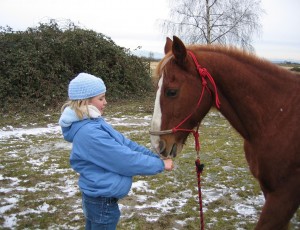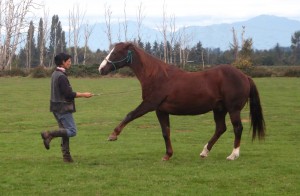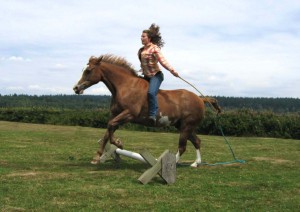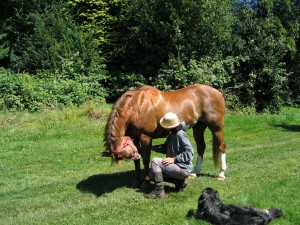How to H.E.M – Help, Explain and Motivate your horse – Part 8
|
|
Helfen, Erklären und Motivieren – Teil 8
|
Training with Positive Reinforcement:
- All behaviourists and modern trainers agree by now that teaching with positive reinforcement is the most effective way. Refer to my book “From Leading to Liberty”(page 19) for explanations in detail what the differences between positive and negative reinforcements, and reward and punishment are.
- Your reinforcement must be something that your horse likes. And to make your own life a lot easier you can almost always use treats for that. That your horse becomes greedy or a “nipper”, when you use treats, is a myth. Biting or grabbing are bad manners, and how to teach him good manners is explained in my book in Game 3 (page 44) – and in the film (“Playing with Horses”) we show how it is done. I stress that this takes an average of 20 minutes per horse and is well worth the effort for harmony in the family in general.
|
|
Training mit Positiver Verstärkung:
- Alle Verhaltenswissenschaftler und moderne Trainer stimmen heutzutage darin überein, daß eine Ausbildung mit positivem Verstärken das effektivste Training darstellt. In meinem Buch “From Leading to Liberty” (Seite 19) erkläre ich die Unterschiede zwischen positiver und negativer Verstärkung, sowie Belohnung und Bestrafung im Detail.
- Die Verstärkung muß etwas sein, was das Pferd mag. Und um sein Trainerleben einfacher zu gestalten kann man fast immer Futterhappen dazu benutzen. Daß Pferde zu Beißern werden, wenn man mit Futter belohnt, ist ein Mythos. Schnappen oder Beißen sind schlechte Manieren, und wie man seinem Pferd gute Manieren beibringt ist in meinem Buch im Spiel 3 (Seite 44) erklärt. In dem Film (“Playing with Horses” – auch auf deutsch!) zeigen wir genau wie es gemacht wird. Ich betone, daß das im Durchschnitt bei allen Pferden lediglich 20 Minuten benötigt, was die Sache wirklich wert ist, wenn man grundsätzlich an Harmonie in der Familie interessiert ist!
|
 Teaching the horse good eating manners only takes 20 minutes
|
- The important thing about reinforcements is that the horse will only “associate”, (i.e. make the mental connection and therefore learn something) between his performance and the reinforcement, if it happens almost simultaneously. Horses are more attentive to small detail than we are: if you asked him to perform a Spanish Step (and your reinforcement came too late) and the horse swished his tail at a fly right afterwards (at which point you praise him for the nice step), he associates the successful nip at the fly with your praise – and has learned nothing in regards to the leg lift.
|
|
- Das Wichtige am „Verstärken“ ist, daß das Pferd nur “assoziiert”, (d.h. eine mentale Verbindung herstellt und daher etwas lernt), wenn seine Leistung und die Verstärkung fast gleichzeitig passieren. Pferde beobachten viel schärfer im Detail als wir – und wenn man beispielsweise einen spanischen Schritt abgerufen hat (die Verstärkung aber zu spät kommt) und das Pferd direkt danach den Schweif nach einer Fliege geschlagen hat (zu welchem Zeitpunkt nun die verspätete Verstärkung erst eintritt), dann assoziiert das Pferd, daß es für seine fabelhafte Treffsicherheit in puncto Fliege gelobt wird – und somit hat es in Bezug auf die Beinhebung natürlich nichts dazugelernt.
|
 Your “good boy!” must come instantly, as soon as he gives a hint of trying to comply! Not only once the exercise is perfect! |
- As you are not necessarily able to feed a treat at just the right moment (because of distance from the horse, position over a jump, etc) you need a “bridging signal”. In clicker training (chapter 10) that would be the click. When playing it is often our “brav!”. The bridging signal tells him: “you were wonderful – treat will follow!”
|
|
- Da man ja aber nicht immer gerade in dem richtigen Moment füttern kann, (z.B. weil man zu weit vom Pferd entfernt ist oder grade gemeinsam über einen Sprung fliegt) braucht man ein “Brückensignal”. Im Klicker Training (Kapitel 10) wäre das der „Klick“. Beim Spielen ist es oft unser “brav!”. Das überbrückende Signal sagt dem Pferd: “Du warst fabelhaft – Belohnung kommt sofort!”
|
 While you are jumping, only the bridging signal can tell your horse how wonderful he is at that moment! And he knows: treat will follow…
|
- When you are just skipping over the jump only your verbal bridging signal can tell your horse how wonderful he is at that moment! And he knows: Treat will follow….
- When your horse has learned good eating manners (Game 3 “strategic feeding”), your treats also become a tool to guide him into certain positions.
|
|
- Beim Seilspringen über den Sprung kann nur das stimmliche Brückensignal dem Pferd mitteilen, wie fabelhaft es ist: Leckerli folgt…
- Wenn das Pferd einmal gute „Freßmanieren“ gelernt hat (Spiel 3 “strategisches Füttern”), dann werden die Belohnungsbrocken auch ein Werkzeug, um es in bestimmte Haltungen zu leiten.
|
 Since the horse follows my feeding hand, I can lead him into – and hold him in! – positions, which are desirable for a healthy stretch. |
- This becomes very important for the “Explain” and “Help” chapters, and is, for the horse, of course much more agreeable than being taught by pulling or shoving him around.
|
|
- Das wird wichtig in den Erklärungs- und Hilfekapiteln, und so angeleitet zu werden ist für das Pferd natürlich immer angenehmer als durch Ziehen oder Schieben „in Position gedrückt“ zu werden.
|
|
| Read on in part 9: „Explain“ to your horse in an effective way, what you want from him.
|
|
Im Teil 9 lernen wir, dem Pferd in effektiver Weise zu „erklären“, was wir von ihm wollen. |





